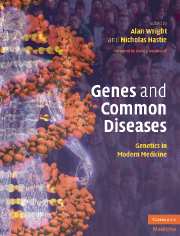Book contents
- Frontmatter
- Contents
- List of Contributors
- Foreword
- Section 1 Introductory Principles
- Section 2 Common Medical Disorders
- 13 Developmental disorders
- 14 Genes, environment and cancer
- 15 The polygenic basis of breast cancer
- 16 TP53: A master gene in normal and tumor suppression
- 17 Genetics of colorectal cancer
- 18 Genetics of autoimmune disease
- 19 Susceptibility to infectious diseases
- 20 Inflammatory bowel diseases
- 21 Genetic anemias
- 22 Genetics of chronic disease: obesity
- 23 Type 2 diabetes mellitus
- 24 Genetics of coronary heart disease
- 25 Genetics of hypertension
- 26 Obstructive pulmonary disease
- 27 Skeletal disorders
- 28 The genetics of common skin diseases
- 29 Molecular genetics of Alzheimer's disease and other adult-onset dementias
- 30 Major psychiatric disorders in adult life
- 31 Speech and language disorders
- 32 Common forms of visual handicap
- 33 Genetic and environmental influences on hearing impairment
- 34 Pharmacogenomics: clinical applications
- Index
- References
31 - Speech and language disorders
Published online by Cambridge University Press: 17 August 2009
- Frontmatter
- Contents
- List of Contributors
- Foreword
- Section 1 Introductory Principles
- Section 2 Common Medical Disorders
- 13 Developmental disorders
- 14 Genes, environment and cancer
- 15 The polygenic basis of breast cancer
- 16 TP53: A master gene in normal and tumor suppression
- 17 Genetics of colorectal cancer
- 18 Genetics of autoimmune disease
- 19 Susceptibility to infectious diseases
- 20 Inflammatory bowel diseases
- 21 Genetic anemias
- 22 Genetics of chronic disease: obesity
- 23 Type 2 diabetes mellitus
- 24 Genetics of coronary heart disease
- 25 Genetics of hypertension
- 26 Obstructive pulmonary disease
- 27 Skeletal disorders
- 28 The genetics of common skin diseases
- 29 Molecular genetics of Alzheimer's disease and other adult-onset dementias
- 30 Major psychiatric disorders in adult life
- 31 Speech and language disorders
- 32 Common forms of visual handicap
- 33 Genetic and environmental influences on hearing impairment
- 34 Pharmacogenomics: clinical applications
- Index
- References
Summary
Introduction
Linguistic impairment is a core diagnostic criterion for a number of developmental disorders, such as autism and specific language impairment (SLI). Uncovering the genetic mechanisms responsible for susceptibility to language impairments will be essential to our understanding of the central deficit underlying speech and language disorders. An overlap between autistic and SLI phenotypes has been proposed based on the shared characteristic of pragmatic language impairment (PLI) in some cases. PLI describes inappropriate communication within a social context and can be observed in a subset of individuals diagnosed with both autism and SLI (Bishop and Norbury, 2002). The existence of a phenotypic overlap suggests that a shared genetic susceptibility may be responsible for some aspects of language delay. This is supported by a higher rate of autism in siblings of probands with SLI than in the general population (3%:0.17% respectively) (Tomblin et al., 2003). It has also been reported that siblings of autistic individuals have higher than expected language and communication deficits (Folstein et al., 1999). Whether these observations indicate a common genetic pathway or intermediate phenotypes common to both disorders is unclear. For example, Bishop and Norbury (2002) found a group of children with PLI also met criteria for autism, whereas another group with PLI including stereotyped language and abnormal intonation were otherwise social and communicative.
The approach taken to identify genes underlying speech and language disorders depends on the genetic model indicated by segregation analysis.
- Type
- Chapter
- Information
- Genes and Common DiseasesGenetics in Modern Medicine, pp. 469 - 487Publisher: Cambridge University PressPrint publication year: 2007



